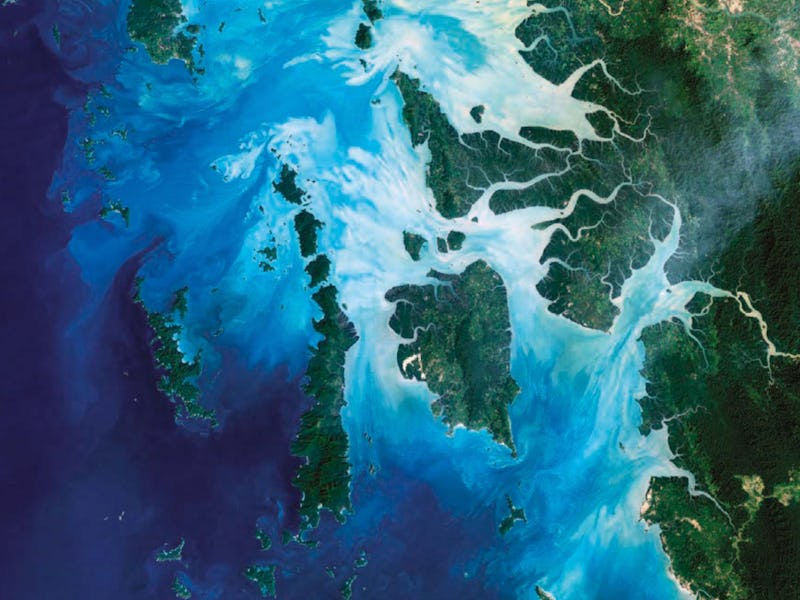Why NASA Left the Cities Out of 'Earth'
"We wanted to take a step back and take a look at the planet without the human signature."

NASA’s stunning new 168-page book features satellite images of the planet’s most artful natural vistas, masses of ocean, swaths of desert, crispy mountain peaks, and lush, dark green forest. Refreshingly, the new book is missing one major aspect of the modern Earth.
There are no sprawling gray masses of city in Earth, a book that examines our planet from the point of view of NASA satellites orbiting above the Earth.
The book instead captures the global scale of natural world, and occasionally notes how the planet is negatively affected by destructive human activity. The opening page of the section called “Ice and Snow” doesn’t directly link CO2 emissions to a warming atmosphere to melting glaciers; it doesn’t have to.
Instead, the book explains how scientists are studying the warming planet: “By observing the response of an iceberg to warmer conditions, scientists can make predictions about how ice shelves — thick slabs of ice attached to coastlines — might respond to a warming climate,” write the authors.
The Mertz Glacier flows off East Antarctica and forms a long, narrow tongue pointing in the direction of Australia and New Zealand. That tongue routinely calves icebergs into the Southern Ocean, and the Earth Observing-1 satellite spotted it doing just that in January 2010.
See also: Let’s Talk About SPHEREx: The Mission to Find the Origin of the Universe
"I don’t find cities all that interesting."
Michael Carlowicz, managing editor at the NASA Earth Observatory and a co-author of Earth, says it presents natural processes, not man-made ones, adding, “I don’t find cities all that interesting.” He also says the authors thought of pairing “before” and “after” photos in the book, but decided not to for layout reasons. (The Earth Observatory’s “World of Change” series, as well as the later “Images of Change” series, already visually show the effects of climate change on the planet.)
"We wanted to take a step back and take a look at the planet without the human signature."
“We wanted to take a step back and take a look at the planet without the human signature,” Carlowicz tells Inverse, who called the book a sort of “greatest hits” of images collected by the NASA Earth science missions.
Additionally, the photos in Earth are presented in their natural state, free of alterations like infrared coloring we often associate with scientific images from NASA.
Finally, Carlowicz says it was important to share images of the Earth that could be used in an educational capacity. “There’s beauty and art in there, but we also see and learn things” from these images.
The cover of 'earth', recently released by NASA.
The book took two years to assemble, Carlowicz says.
“For all of the dynamism and detail we can observe from orbit, sometimes it is worth stepping back and simply admiring Earth. It is a beautiful, awe-inspiring place, and it is the only world most of us will ever know,” he writes in the book’s foreword.
Thankfully, Earth excludes the Earth’s cities, choosing to instead focus on the planet’s natural splendor.
Carlowicz credits Lawrence Friedl, program director for the Applied Sciences Program in NASA’s Science Mission Directorate, Earth Science Division, as the impetus for writing the book. Carlowicz, Friedl, and Kevin Ward are the book’s three authors.
“We hope these images inspire everyone to explore, understand, and appreciate the planet we call home,” Friedl said in a statement released with a book.
The book includes 69 different images, each paired with a scientific explanation of the image. There are version for e-readers, a PDF version, and an HTML version. If you’d prefer to own the physical copy, NASA is selling it for $53.